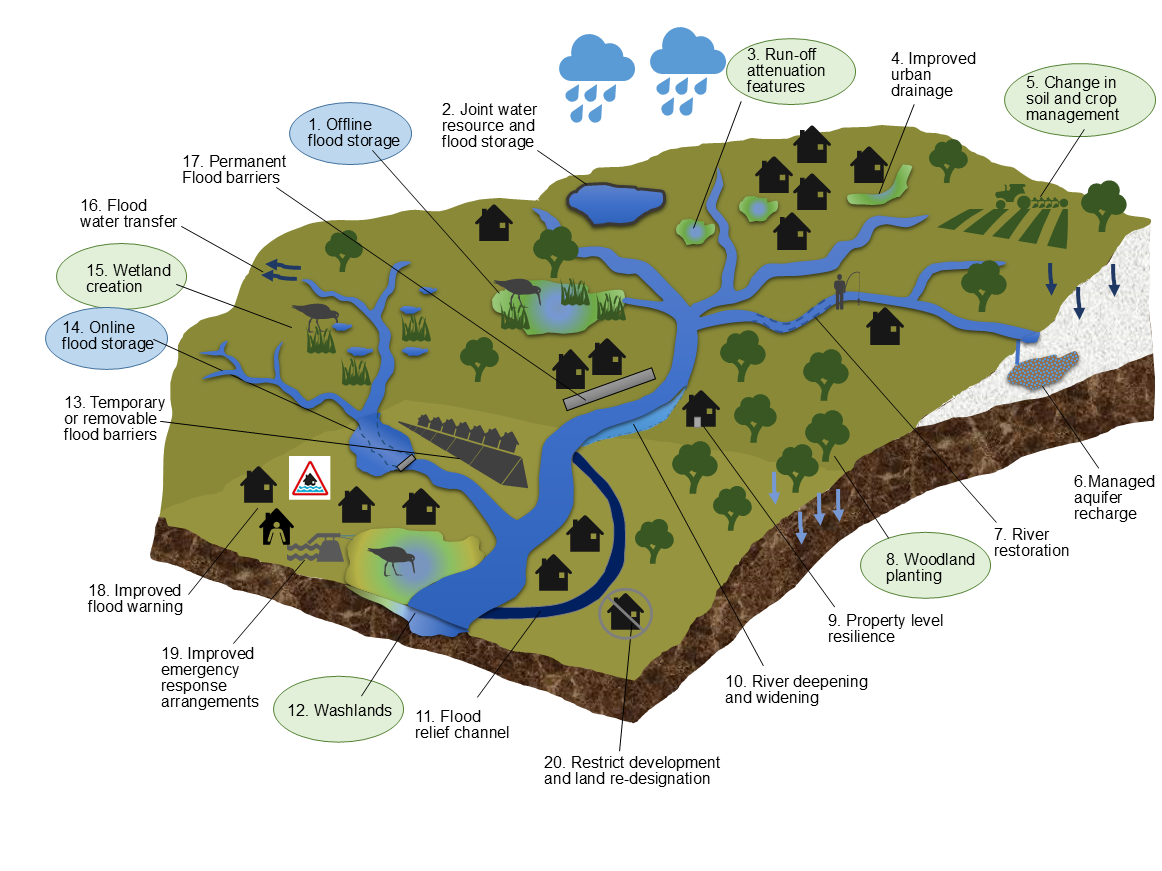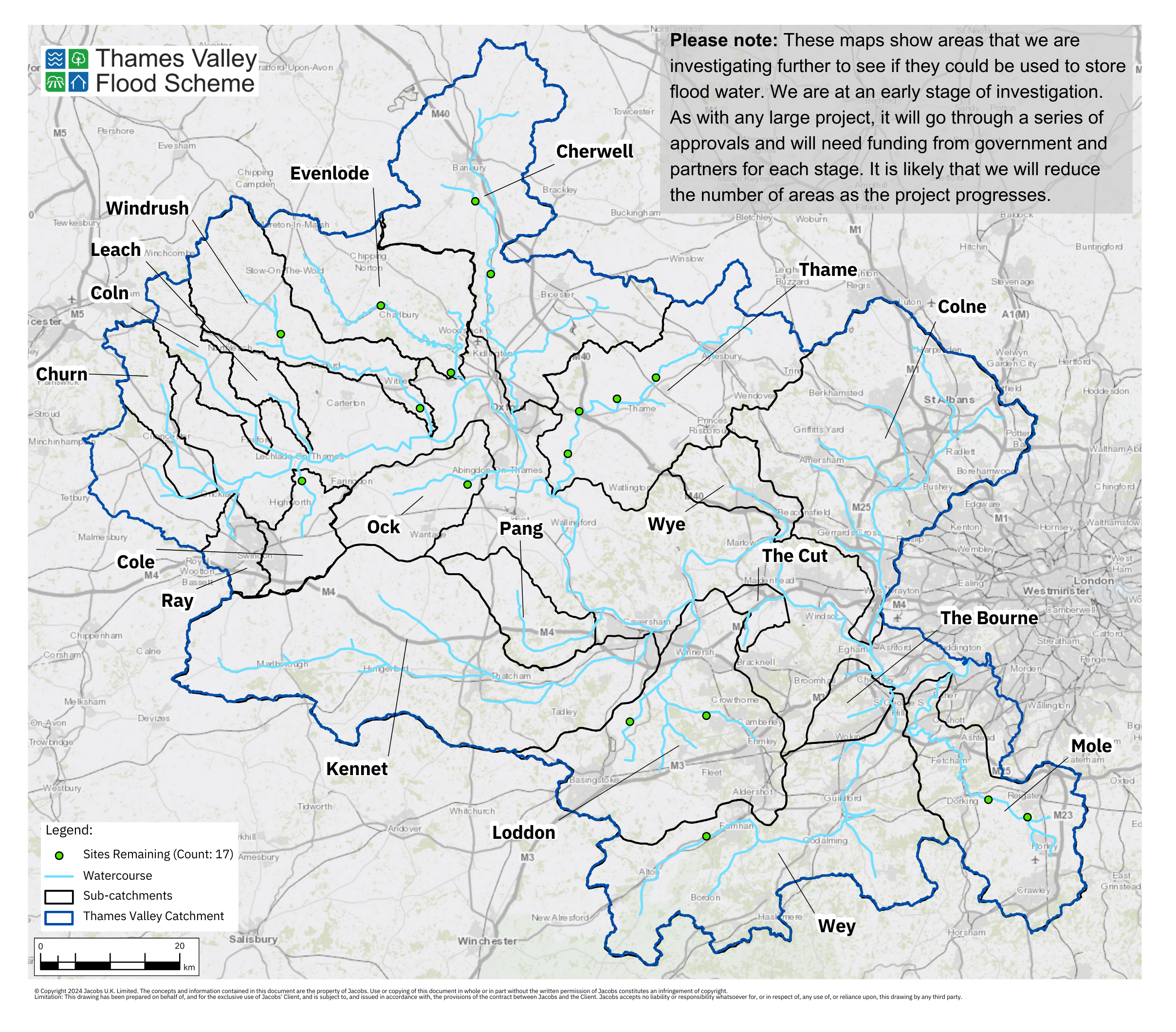Thames Valley Flood Scheme
Thames Valley Flood Scheme findings
Thames Valley Flood Scheme aimed to develop large scale flood storage areas within the Thames catchment to reduce flood risk downstream. We found that large scale flood storage does have potential to help reduce flood risk, but the benefits in reducing flood risk would not be enough to gain funding and approvals.
This means that we are not able to proceed with the Thames Valley Flood Scheme at this time.
Moving forward
While we are not continuing to develop catchment wide flood storage at this time, we at the Environment Agency remain dedicated to reducing flooding in the Thames area. We know how important it is to keep our communities safe from floods.
We’ll use what we’ve learned from this project to improve our future work. To do this, we will:
- Investigate ways to manage flood risk in other areas where schemes are not yet planned.
- Progress other planned flood risk schemes, like the River Thames Scheme and the Oxford Flood Alleviation Scheme.
- Work with local councils to support their surface water schemes and explore smaller scale opportunities to manage flood risk in the area.
- Continue to warn and inform communities when a flood is expected through our Flood Warning Service, giving people time to act.
- Keep working with communities to ensure those at flood risk are aware and know how to prepare and respond.
- Share our improved flood risk data with local councils in the Thames catchment area and the Thames Regional Flood and Coastal Committee to support local flood response plans.
What did we do?
The Thames Valley Flood Scheme investigated ways to manage flood risk on a large scale across the Thames area. We developed an approach to look into ways to reduce flood risk and enhance the natural environment at a scale that hadn’t previously been considered across the Thames catchment. Our work showed that large scale flood storage supported by natural flood management could reduce flood risk in the Thames Valley.
We assessed 20 different approaches to see if they could work on their own to reduce flood risk across the Thames Valley. We identified that flood storage, circled in blue, would need to be part of the scheme. Natural flood management options, circled in green, could have worked to complement flood storage. When combined, these had potential to provide long-term benefits and meet the overall aims of the scheme.

Flood storage
We initially assessed over 700 locations for flood storage and then narrowed these down to 17 areas for further investigation. These were locations where a flood storage area could be effective in reducing flood risk, while minimising impact on the local area. These locations are shown as green dots on the map. You can find out about the process we followed by reading our report and February 2024 newsletter.
We then reviewed the costs and flood risk benefits of using individual or small groups of flood storage sites to reduce flood risk. We compared the cost of building flood storage areas against the potential to reduce financial and societal damage from flooding downstream. This helped to show us whether the scheme was good value for money. For a scheme to go ahead, the benefits must significantly outweigh the costs.
A number of locations had a positive cost-benefit ratio, and we looked at these in more detail. We considered the local reduction to flood risk in each area, other existing and planned work in the Thames Area, resources needed, and likelihood of gaining funding and approval at this time. Having considered these factors, we decided not to progress any large-scale flood storage areas as individual projects. If economic rules change or climate change has bigger impacts than expected, then the project may be reevaluated.
Natural Flood Management
We considered different approaches to incorporating natural flood management into the Thames Valley Flood Scheme.
There are lots of benefits of natural flood management. It can bring local flood risk benefits, enhance human wellbeing, improve water supply and quality, reduce drought impacts and improve the natural habitat. The Environment Agency and partner organisations have delivered many natural flood management projects across the Thames Valley, with others still in progress.
We also explored how we can support natural flood management work being completed by partners and communities across the Thames Valley. Natural flood management has many benefits beyond flood risk, and the Environment Agency will continue to support the great work already happening across the catchment.
Funding
Flood and coastal erosion risk management (FCERM) in the UK is funded from several different sources. The Government provides most of its funding for FCERM to the Environment Agency and other Risk Management Authorities as Grant-in-Aid (GiA). For many projects, including the Thames Valley Flood Scheme, where GiA funding does not cover all costs, the balance must be secured from private and public sector partners and the local communities and businesses that will benefit from the scheme. This is known as partnership funding, which is supported by the national FCERM Strategy as a means of delivering local priorities and providing communities and businesses with a say in what is done to reduce flood risk in their area.
The amount of funding a project can attract from different sources will depend on the benefits it provides. Considering the overall costs and benefits alongside the funding available, our catchment scale scheme is not considered feasible to take forward at this time.
